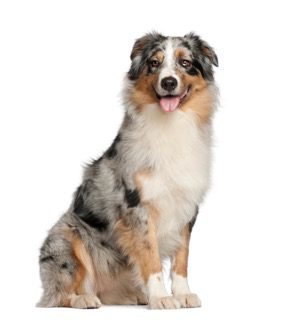
The Australian Shepherd is a medium-sized herding dog originating from the western United States. Their history dates back to the early 19th century, when they were a part of the Spanish Basque Shepherd family, but they soon became popular among ranchers in the Western United States. They are known for their high intelligence, strong work ethic and loyalty to their owners.
Australian Shepherds have strong, muscular physiques with medium-length, double coats that can be smooth or rough and come in a variety of colors. They have short, sloped backs, medium-sized muzzles, and drop ears with feathered edges. They are medium-sized dogs, usually weighing between 40 and 65 pounds and standing about 20–22 inches tall.
Common color variations include black, blue merle, red, red merle, isabella, and tan. They may also have white markings on their chests, faces, legs and tails.
The Australian Shepherd is an intelligent, loyal, and playful breed. They are very friendly and get along well with children and other pets when raised and socialized properly. Early and regular training will help ensure that they remain obedient and respectful of each family member. This highly energetic breed will need regular exercise and activity, preferably daily, to remain balanced and engaged. Walks, jogs, runs, and playtime are all great activities that the Australian Shepherd enjoys. Aussies are an active indoor pet and do well even if their exercise needs aren’t met with a lot of outdoor play. Although they are highly trainable, they don’t generally tolerate loud noises and may become uncomfortable with large crowds. Furthermore, their strong devotion and willingness to please make Australian Shepherds wonderful companions who can form strong bonds with their owners.
What makes Australian Shepherds so special is their intelligence, agility and strong work ethic. This makes them ideal for a variety of tasks, such as herding, search and rescue, agility and obedience competitions. Their size, trainability, and affinity for people make them great family dogs too. This is what sets them apart from other herding breeds such as Border Collies and Australian Cattle Dogs.
The Australian Shepherd is a beautiful, medium-sized breed of dog that is well known for its intelligence and loyalty. They thrive with plenty of physical and mental exercise, but equally important is a nutritious and balanced diet. Australian Shepherds require high-quality food that is formulated to meet their specific nutritional requirements and feeding guidelines. It’s also important to regulate snacking and restrict access to unhealthy treats and table scraps. Responsible ownership and adoption means providing ample care, love, and nutrition for your pet.
To learn more about your Australian Shepherd’s dietary needs, be sure to check out Way Canina to find out the best foods to feed your pup and which ones to avoid. Providing a healthy, nutritious, and balanced diet is the key to strong and vibrant life for your Australian Shepherd. Keep these tips in mind, enjoy your pup, and be sure to check out Way Canina to get the best advice for your special pup.
Common health issues and genetic predispositions that affect Australian Shepherds include hip and elbow dysplasia, eye problems, and some heritable heart issues. Regular veterinary check-ups, vaccinations, and preventive care are essential to ensure the health and well-being of your Australian Shepherd; professional guidance from your veterinarian is critical. Grooming needs such as brushing, bathing, and ear cleaning are also important considerations to ensure your Aussie looks and feels its best.
Australian Shepherds typically have a life expectancy of 10-15 years, however, their longevity can be influenced by genetics, diet, exercise, and healthcare. It’s important to keep your vet records, diet, and exercise routine up to date to ensure your Australian Shepherd has a long, healthy life.
Are you thinking about getting an Australian Shepherd or do you already own one? Either way, it’s important to consider all that comes with owning this breed. Think about all the responsibilities as well as the pros and cons of owning this particular breed. For more information, check out Way Canina’s blog posts and articles on comparing different breeds and learn more about dogs’ lifestyle and wellbeing.